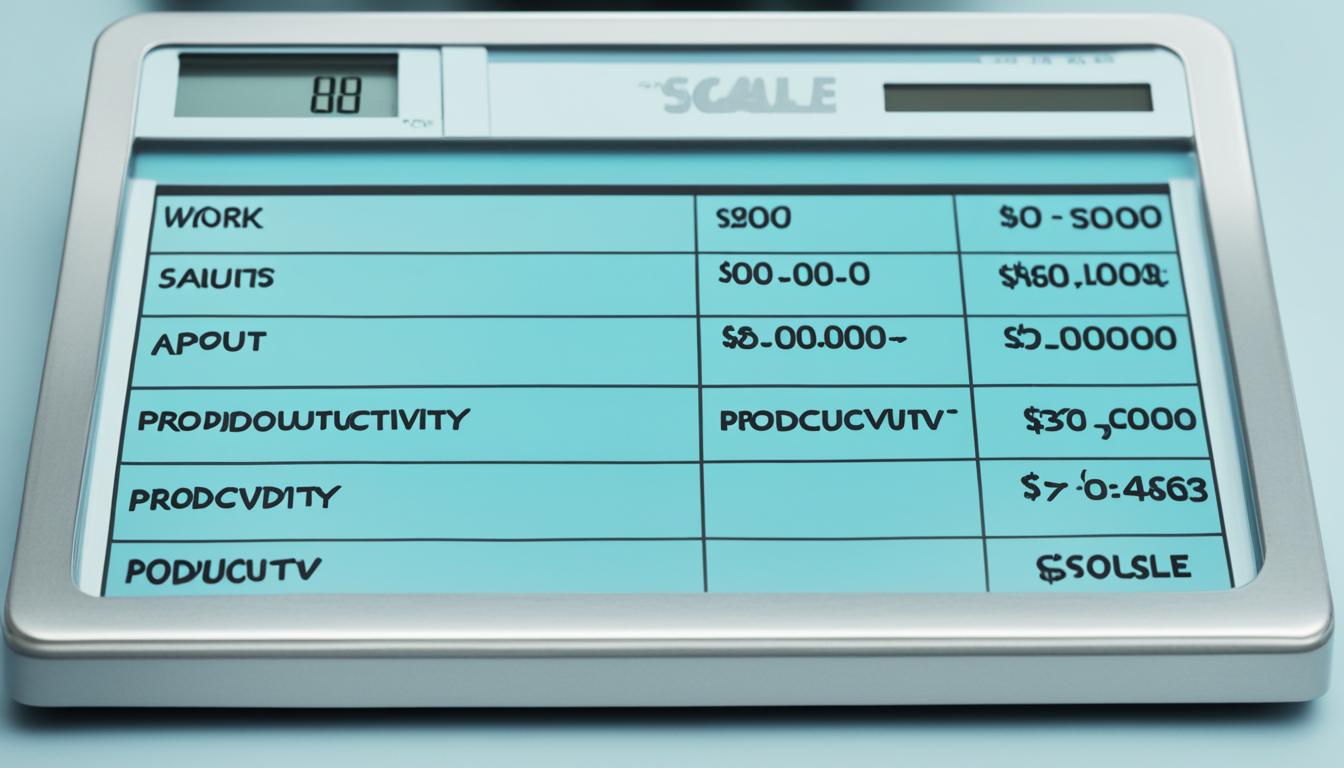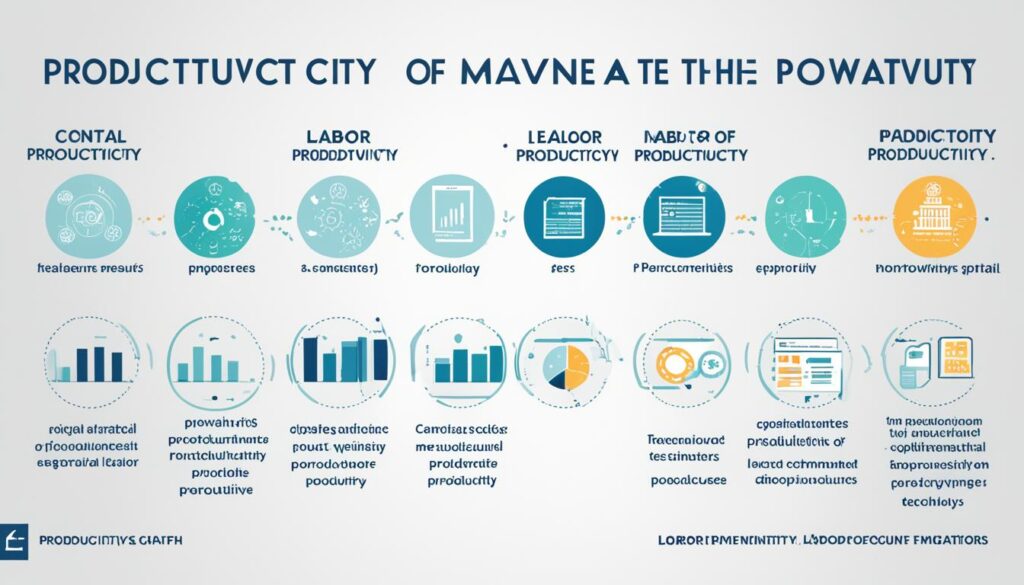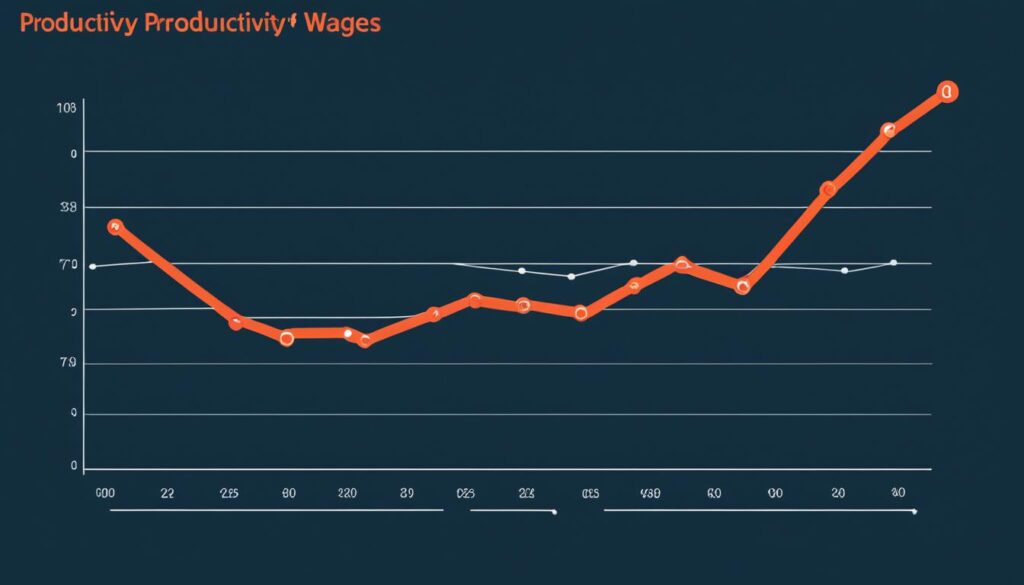Unlock Your Worth: Productivity vs Wages Explained

Are you confident that your productivity is truly being reflected in your wages? Do you feel like your hard work is not translating into the financial growth you desire? Understanding the relationship between productivity and wages is crucial for maximizing your worth in the workforce. Let’s explore the intricacies of labor productivity, wage growth, and economic output to uncover the key factors that determine your income and challenge common beliefs about productivity and compensation.
Key Takeaways:
- Labor productivity plays a significant role in determining wages and financial growth.
- Understanding the different measures of productivity, such as partial, multifactor, and total factor productivity, provides insights into different aspects of work efficiency.
- The law of diminishing marginal productivity highlights how adding more input to a production process can eventually lead to decreased returns.
- Productivity tracking allows individuals and organizations to measure, monitor, and improve efficiency.
- Challenging the expectation of perfect productivity and embracing normal work habits can lead to a healthier and more productive work environment.
The Different Measures of Productivity: Partial, Multifactor, and Total Factor Productivity
When it comes to assessing productivity, there are several methods that can provide valuable insights. It’s important to understand these different measures in order to gain a comprehensive understanding of productivity levels in various industries.
One commonly used measure is partial factor productivity. This measure calculates the ratio of total output to a single input, such as labor, capital, or materials. It allows organizations to assess the productivity achieved with a specific input and provide insights into ways to improve efficiency. Here’s a breakdown of the formula:
| Partial Factor Productivity | Formula |
|---|---|
| Output | Total output produced |
| Input | Single input used (e.g., labor, capital, materials) |
On the other hand, multifactor productivity takes into account the ratio of total outputs to a subset of inputs. This measure offers a more comprehensive assessment of productivity by considering multiple inputs simultaneously. By analyzing the relationship between various inputs and outputs, organizations can gain a deeper understanding of their overall efficiency. The formula for multifactor productivity is as follows:
| Multifactor Productivity | Formula |
|---|---|
| Output | Total output produced |
| Inputs | Subset of inputs used (e.g., labor, capital, materials) |
Total factor productivity provides a holistic measure by considering all resources utilized in the production process and dividing it by the total output. This measure accounts for the combined impact of labor, capital, materials, and other inputs, providing a comprehensive snapshot of overall productivity. Here’s the formula for total factor productivity:
| Total Factor Productivity | Formula |
|---|---|
| Output | Total output produced |
| Inputs | All resources used in production (e.g., labor, capital, materials) |
Each measure of productivity offers unique insights into different aspects of efficiency in the production process. By incorporating these measures into the analysis, organizations can identify areas for improvement and make informed decisions to optimize productivity levels.

The Law of Diminishing Marginal Productivity and Its Impact
The law of diminishing marginal productivity is a fundamental concept in economics that has a significant impact on the efficiency of production processes. According to this law, as more units of input are added to a production process, the additional output generated by each additional unit will eventually decrease.
This principle arises from the concept of diminishing returns, which states that as more of a good or service is produced, the incremental gain from each additional unit diminishes. This means that the initial increase in output observed when adding more input eventually reaches a point of saturation, where the marginal productivity begins to decline.
The law of diminishing marginal productivity has implications for businesses across various industries. Understanding this concept allows managers and decision-makers to effectively allocate resources and optimize the production process to achieve maximum output.
Factors Affecting the Applicability of the Law
- Changes in Technology: Technological advancements can influence the applicability of the law. New technologies may enable businesses to overcome the limitations imposed by the law and increase productivity levels.
- Management Practices: Effective management practices, such as efficient utilization of resources and streamlined workflows, can mitigate the impact of diminishing marginal productivity.
- Demand: Changes in market demand can affect the productivity levels of a business. Variations in demand may necessitate adjustments in production processes to maintain optimal output.
By considering these factors, businesses can adapt their strategies and explore opportunities to enhance productivity despite the constraints imposed by the law of diminishing marginal productivity.

The law of diminishing marginal productivity serves as a reminder to continually seek improvements in the production process. It highlights the importance of innovation, efficient resource allocation, and strategic decision-making in managing input-output dynamics. By understanding and leveraging the insights derived from this law, businesses can enhance their competitiveness, adapt to changing market conditions, and achieve sustainable growth.
The Importance of Productivity Tracking for Personal and Professional Growth
In order to maximize your personal and professional growth, it is crucial to have a clear understanding of your productivity levels. Productivity tracking, which involves measuring and monitoring your productivity, can provide valuable insights into areas of improvement. By setting goals, tracking your progress, and utilizing tools like project management software or productivity tracking software, you can enhance your efficiency and overcome potential obstacles.
One of the key benefits of productivity tracking is the ability to set clear goals. By defining specific objectives and benchmarks, you create a roadmap for success. Productivity tracking allows you to measure your progress towards these goals and make adjustments as needed, ensuring that you stay on track towards achievement.
Monitoring your productivity also helps you identify areas of improvement. By analyzing how you spend your time and energy, you can pinpoint inefficiencies and make necessary adjustments. This enables you to optimize your personal productivity and make the most of your resources.
Productivity tracking can also be a powerful motivator. Seeing your progress and accomplishments on a regular basis can boost your confidence and inspire you to strive for even greater success. It provides a visual representation of your efforts, showing you the tangible results of your hard work.
Benefits of Productivity Tracking:
- Measuring and monitoring productivity
- Setting goals and benchmarks
- Tracking progress towards objectives
- Identifying areas for improvement
- Optimizing personal productivity
- Motivating and inspiring self-improvement
Whether you are an individual looking to enhance your personal productivity or an organization seeking to improve efficiency, productivity tracking is a valuable tool. It provides a clear picture of your progress and enables you to make data-driven decisions for continuous improvement.
![]()
Challenging the Expectation of Perfect Productivity: Understanding Normal Work Habits
When it comes to work habits and productivity, there is a pervasive expectation of perfection. The idea that you must work every minute of your workday without any breaks or downtime is simply not reasonable or sustainable. It is essential to understand that normal work habits include taking breaks, engaging in downtime activities, and addressing personal needs throughout the day. By embracing these normal activities and challenging the expectation of perfect productivity, you can create a healthier and more balanced work environment.
It’s important to communicate with your supervisors and colleagues about the necessity of taking breaks and engaging in activities that help you recharge. By openly discussing the importance of these normal work habits, you can foster understanding and support from those around you.
Additionally, it is crucial to ensure that productivity tracking systems account for breaks and downtime activities. Time tracking tools and software should recognize the importance of these normal activities and allow you to log them without penalizing your productivity scores.
By challenging the unrealistic expectation of perfect productivity and emphasizing the need for reasonable work habits, you can achieve a more productive work environment. Recognize that breaks and downtime are not distractions but rather important components of a well-rounded workday.
The Benefits of Normal Work Habits
Engaging in breaks and downtime activities throughout the workday offers numerous benefits. Taking regular breaks can actually boost your overall productivity and focus. When you allow yourself moments of rest, you give your brain the opportunity to recharge and rejuvenate, leading to increased creativity, problem-solving abilities, and overall work performance.
Furthermore, addressing personal needs and engaging in activities you enjoy during breaks and downtime can improve your overall well-being and mental health. By taking care of yourself and finding moments of relaxation and enjoyment, you can reduce stress levels and maintain a healthy work-life balance.
Remember, balancing work and personal needs is not a sign of laziness or lack of dedication. It is a crucial aspect of self-care and ensuring your long-term productivity and success.
Creating a Work Schedule that Incorporates Normal Work Habits
To integrate normal work habits into your routine, consider creating a work schedule that allows for breaks and downtime. Here’s an example:
| Time | Activity |
|---|---|
| 9:00 AM – 9:15 AM | Quick stretch and hydration break |
| 11:00 AM – 11:30 AM | Lunch break |
| 3:00 PM – 3:15 PM | Short walk or relaxation exercise |
By setting specific times for breaks and downtime activities, you create a structured routine that supports both your productivity and your well-being. Remember to adjust these times based on your personal preferences and work requirements.
It is essential to prioritize and protect these normal work habits just as you would any other work-related task or responsibility. By incorporating breaks and downtime activities into your schedule, you can maintain a healthy work-life balance and enhance your overall productivity.

The Link Between Productivity Tracking and the Law of Diminishing Marginal Productivity
Productivity tracking is a powerful tool that can shed light on the impact of the law of diminishing marginal productivity in the workplace. As employees spend more time working, their productivity levels may decrease due to various factors. By monitoring this phenomenon, employers can make informed decisions about resource allocation and workflow improvement. Recognizing the correlation between productivity tracking and the law of diminishing marginal productivity can lead to optimized productivity levels and the avoidance of inefficiencies.
When employees spend excessive time on a task, they may experience a decline in productivity. This decrease can be attributed to factors such as fatigue, reduced focus, or diminishing creativity. Productivity tracking enables employers to identify patterns in productivity decrease over time, allowing for proactive measures to be taken. By allocating resources strategically and optimizing employee efficiency, organizations can minimize the negative effects of diminishing marginal productivity. Additionally, workflow improvement initiatives can be implemented based on insights gained from productivity tracking data.
Through productivity tracking, employers can gain a comprehensive understanding of how the law of diminishing marginal productivity manifests in their workforce. This knowledge empowers them to adopt effective strategies to maintain and enhance employee efficiency. By setting realistic expectations and encouraging breaks and downtime to prevent burnout, organizations can create a healthier work environment that promotes sustainable productivity levels.
Let’s take a closer look at how productivity tracking can help in resource allocation and workflow improvement. The table below provides a hypothetical illustrative example of how productivity decreases as the number of hours worked increases:
| Hours Worked | Productivity Level |
|---|---|
| 0-2 | High |
| 2-4 | Moderate |
| 4-6 | Low |
| 6-8 | Decreased |
The table above demonstrates a decrease in productivity as the number of hours worked increases. This serves as a clear example of the law of diminishing marginal productivity in action. By tracking productivity levels over time, employers can identify the optimal number of hours in which employees maintain high productivity. This information can be utilized in resource allocation and scheduling to ensure efficiency and avoid overworking individuals.
In summary, productivity tracking provides valuable insights into the link between productivity decrease and the law of diminishing marginal productivity. By implementing productivity tracking measures, employers can intelligently allocate resources, improve workflow, and promote employee efficiency. Understanding and managing the impact of diminishing marginal productivity is key to unlocking maximum productivity in the workplace.
The Benefits of Productivity Tracking Software for Enhanced Efficiency
In today’s fast-paced world, improving productivity is essential for staying ahead and achieving success. One powerful tool that can help individuals and organizations boost their productivity is productivity tracking software. By harnessing the capabilities of this software, you can measure your work, set goals, track progress, manage tasks, and ultimately enhance your efficiency.
Here are some key benefits of using productivity tracking software:
- Measuring Work: Productivity tracking software allows you to measure your work in small increments, providing accurate data on the time and effort you invest into tasks and projects. This information enables you to gain insights into your productivity levels and identify areas for improvement.
- Setting Goals: With productivity tracking software, you can set realistic goals based on your desired outcomes and milestones. By breaking down larger objectives into smaller, more manageable tasks, you can stay focused and organized, ensuring steady progress towards your targets.
- Progress Tracking: The software enables you to track your progress in real-time, giving you a clear overview of the tasks completed, pending, or in progress. This visibility allows you to stay on top of your workload, prioritize effectively, and make any necessary adjustments to meet deadlines or optimize your workflow.
- Task Management: Productivity tracking software provides robust task management features, allowing you to create, assign, and delegate tasks efficiently. With features like reminders, deadlines, and task dependencies, you can better manage your responsibilities and ensure that nothing falls through the cracks.
- Efficiency Improvement: By analyzing the data collected through productivity tracking software, you can identify areas where your efficiency can be improved. Whether it’s reducing time spent on unproductive activities, identifying bottlenecks in your workflow, or optimizing resource allocation, this software empowers you to make data-driven decisions for enhanced efficiency.
With productivity tracking software at your disposal, you can unlock your full potential, streamline your work processes, and achieve your goals more effectively. It’s a valuable tool for individuals, teams, and organizations aiming to maximize productivity and make continuous improvements.
| Key Benefits of Productivity Tracking Software |
|---|
| Measuring Work |
| Setting Goals |
| Progress Tracking |
| Task Management |
| Efficiency Improvement |
Conclusion
Productivity and wages are fundamental factors in achieving professional success and financial growth. By understanding and utilizing productivity measures like partial, multifactor, and total factor productivity, individuals can effectively bridge the gap between their productivity levels and wages, thereby maximizing their worth in the workforce.
To further enhance efficiency and overall fulfillment, it is crucial to recognize the impact of the law of diminishing marginal productivity. This principle highlights the decrease in additional output as more units of input are added to the production process. By implementing effective productivity tracking methods, including the use of productivity tracking software, individuals can optimize their time and resources, avoiding inefficiencies and driving growth.
Productivity tracking software offers numerous benefits in terms of enhanced efficiency. It allows for precise measurement of work, facilitates goal-setting and progress tracking, and streamlines task management. By leveraging the power of productivity tracking software, individuals can stay organized, make continuous improvements, and achieve their goals with greater ease and effectiveness.
In conclusion, by embracing productivity tracking and intertwining it with the understanding of productivity and wages, individuals can unlock their true worth. This synergy fosters financial growth, personal fulfillment, and professional success, creating a harmonious balance between productivity and compensation.






